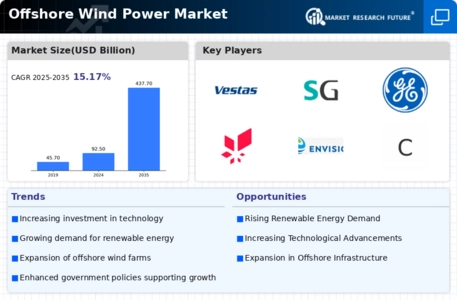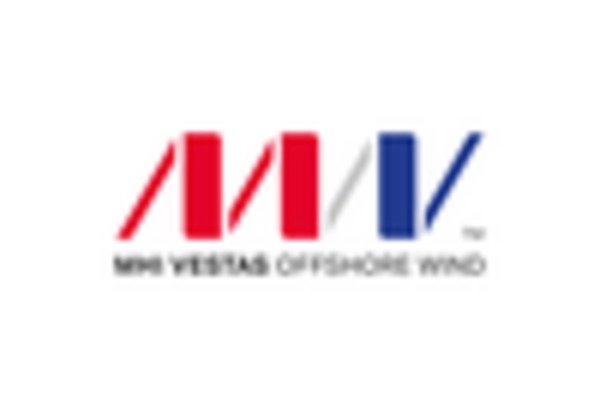The Offshore Wind Power Market is currently characterized by a dynamic competitive landscape, driven by increasing demand for renewable energy and a global push towards sustainability. Key players such as Ørsted (DK), Siemens Gamesa (ES), and GE Renewable Energy (US) are at the forefront, each adopting distinct strategies to enhance their market positioning. Ørsted (DK) focuses on innovation and technological advancements, particularly in turbine efficiency and energy storage solutions, while Siemens Gamesa (ES) emphasizes strategic partnerships to expand its footprint in emerging markets. GE Renewable Energy (US) is leveraging its extensive experience in the energy sector to optimize supply chains and enhance operational efficiencies, thereby shaping a competitive environment that is increasingly reliant on technological prowess and strategic collaborations.
The business tactics employed by these companies reflect a concerted effort to localize manufacturing and optimize supply chains, which are critical in a moderately fragmented market. This competitive structure allows for a diverse range of players to coexist, yet the influence of major companies is palpable. Their ability to innovate and adapt to regional demands positions them as leaders in the market, while also fostering a competitive atmosphere that encourages smaller firms to enhance their offerings.
In August 2025, Ørsted (DK) announced a groundbreaking partnership with a leading battery storage company to develop integrated offshore wind and energy storage solutions. This strategic move is poised to enhance the reliability of energy supply from offshore wind farms, addressing one of the critical challenges in renewable energy deployment. By combining wind energy generation with advanced storage capabilities, Ørsted (DK) aims to provide a more stable and efficient energy solution, potentially setting a new standard in the industry.
In September 2025, Siemens Gamesa (ES) unveiled its latest offshore wind turbine model, which boasts a significant increase in capacity and efficiency. This innovation is expected to reduce the cost of energy production, thereby enhancing the company's competitive edge. The introduction of this turbine aligns with global trends towards larger, more efficient wind farms, and positions Siemens Gamesa (ES) as a leader in technological advancement within the sector.
In July 2025, GE Renewable Energy (US) secured a major contract for the supply of wind turbines for a large-scale offshore project in the North Sea. This contract not only reinforces GE's market presence but also highlights its commitment to expanding its operational capabilities in key regions. The strategic importance of this contract lies in its potential to enhance GE's reputation as a reliable supplier in the offshore wind sector, further solidifying its competitive position.
As of October 2025, the Offshore Wind Power Market is witnessing trends that emphasize digitalization, sustainability, and the integration of artificial intelligence in operational processes. Strategic alliances are increasingly shaping the competitive landscape, enabling companies to pool resources and expertise to tackle complex challenges. Looking ahead, the competitive differentiation in this market is likely to evolve from traditional price-based competition to a focus on innovation, technological advancements, and supply chain reliability, reflecting the industry's shift towards a more sustainable and efficient future.

















Leave a Comment